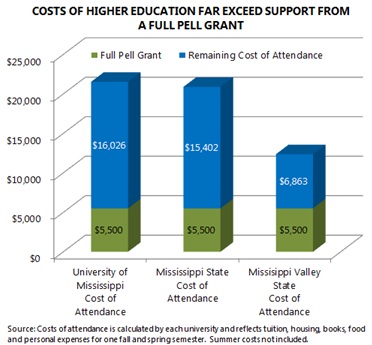A recent post discusses changes in the income of Mississippi’s households relative to the increasingly costs of colleges and universities in the state.
For low-income students that are eligible for support through the federal Pell Grant program, a full Pell Grant provides much needed support to help offset some of the costs of pursuing a college degree. In 2011, 137,000 students at colleges and universities in Mississippi were eligible for a full Pell Grant – equal to 58% of students that applied for financial aid in the state.
However, it is important to note that even students receiving a full Pell Grant have thousands of dollars in costs remaining each year they pursue higher education. The result is that students at Mississippi’s universities still need to find outside funding sources or take out loans to pay for attending college.
The figure shows the value of a full Pell Grant in 2012 ($5,500) and the remaining cost to undergraduates of attending three different Mississippi universities. The costs of attendance above and beyond a Pell Grant range from $16,026 at the University of Mississippi main campus to $6,863 at Mississippi Valley State each year. The gap between Pell funding and the cost of attendance would be true for each year the student attends the university. Costs of attendance include most expenses a student would incur while in school including: tuition, housing, food, books and other basic expenses.
The costs of pursuing a 4-year degree far outpace federal need-based aid underscoring the importance of other financial aid sources for students. On the state level, state need-based aid can play a critical part in helping students reduce the debt burden incurred while pursuing higher education.
Each of Mississippi’s 3 statewide grant programs for financial aid was developed in the 1990s. Only one of Mississippi’s state financial aid grants is awarded on the basis of financial need of the student. Additionally, the state’s largest grant program, MTAG, excludes students that are eligible for the full Pell Grant amount. As the costs of higher education continue to rise and family incomes continue to stagnate, it is critical that state leaders consider how financial aid policies for these programs can better help students fill the gap between their Pell awards and the cost of attendance at universities.






